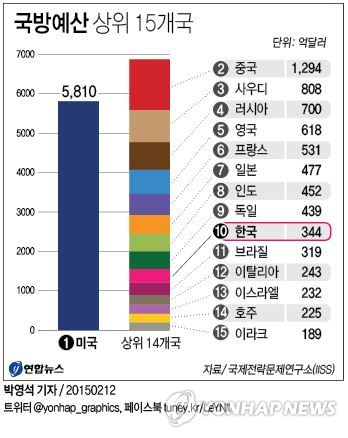2014년 국가 국방비 지출 상위 15개국 The Military Balance - 2014's top defence spenders

By Giri Rajendran, Research Associate for Defence and Economics A regular feature in The Military Balance is the updated graphic of the top 15 official defence budgets around the world*. There are significant changes in this year’s chart. For instance, after displacing the United Kingdom at fourth position last year, Saudi Arabia has risen this year into third place, above Russia, after sustained increments to the official Saudi defence budget in 2014. . Also, 2014 saw India rise to eighth place – above Germany – after New Delhi opted to raise its defence budget following Narendra Modi’s election victory that year, while Berlin opted to cut spending due to procurement delays and federal budget consolidation aimed at reducing public debt levels. That said, this year’s chart still reflects characteristics common to previous editions, such as the wide differential between US defence outlays relative to other states: the US spends almost as much as the next 14 largest spenders combined, and some 4.5 times more than the official budget of the world’s second largest spender, China. However, as was pointed out during last year’s launch, arriving at meaningful international comparisons of defence-spending levels is problematic. For example, Russia’s official defence budget has fallen below that of Saudi Arabia, in US dollar terms. This is partly because the rouble has depreciated over the past year due to declining oil prices and economic sanctions: a weaker rouble shrinks the value of Russian defence outlays in US dollars when exchange rate conversions are made using average annual market exchange rates. Similarly, Japanese defence spending levels – in US dollar terms – have fallen substantially in recent years, due to the drastic currency depreciation caused by Japan’s monetary policies under ‘Abenomics’, despite the country’s defence budget actually rising in yen terms. Additionally, the chart depicts official defence budgets*, but countries differ on the precise elements they include under this budget line. The impact of this can be significant: the only official figure on defence spending released by Saudi Arabia is the country’s ‘defence and security’ budget, which includes funding for the Ministry of the Interior as well as the Ministry of Defence; while Russia’s official ‘national defence’ budget excludes some outlays on military pensions, paramilitaries and other military benefits, such as housing and healthcare. Nor are these the only examples of how budget definitions matter when comparing military expenditure across countries. In recent years, the US has included at least some US$20 billion in defence-related funding under other budget lines, such as disbursements on mandatory spending and through the Department of the Treasury’s budget (both of which fund some military retirement and healthcare costs). And China – which along with Saudi Arabia has one of the least transparent defence budgets in the world – is widely believed to exclude from its official defence budget funding for a significant proportion of its defence-related research and development programmes. The fact that budgetary definitions are often not publicised adds to the difficulty in ascertaining precise disbursements Furthermore, the paucity of directly comparable information in the area of defence budgeting – along with movements in exchange rates – complicates assessments of cross-regional defence spending comparisons. The nuances inherent in defence-budgeting practices around the world are analysed in detail in the national, regional and extensive data sections contained in The Military Balance 2015. * Figures also include US Foreign Military Assistance (FMA) funding for relevant countries https://www.iiss.org/en/militarybalanceblog/blogsections/2015-090c/february-8272/2014-top-defence-spenders-bb5d |
edited by kcontents
"from past to future"
데일리건설뉴스 construction news
콘페이퍼 conpaper
.










